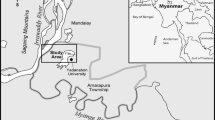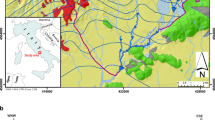Abstract
Geochemical and mathematical methods are presented, which include NETPATH model and the Moore-Penrose pseudo-inverse (MPPI) to quantify the contributions of water from distinct recharge areas and aquifers to public supply wells in the city of Madison, Wisconsin. Previous studies investigated the hydraulic connectivity between different aquifers in the study area and proved the impact of the shallower aquifers as well as the surface water on some of the deep wells, but did not address the percentages of the contributions of such sources. The MPPI, executed by MATLAB code, in conjunction with the inverse-based NETPATH model was used to estimate the mixing proportions of four end members (“initials”) in some of the deep groundwater wells. The quantitative estimation of the contribution of the different water resources (reference waters) on the water extracted from the deep municipal wells is considered as the main ultimate goal of this manuscript. Therefore, in this paper, many tools including WATEQ program, NETPATH and MPPI codes, were applied to verify the influence of such reference waters as well as to assess their ratios in the deep municipal wells. Datasets including major ion chemistry and stable isotopes (such as δ18O and δD) data were manipulated to determine similarities and differences between the samples and reference waters. These data provided a basis for selecting and grouping of the samples that are believed to be affected by mixing. The results showed that there are two groups of wells; one group was mainly affected by the deeper Mount Simon water (about 70%), while the second group showed a slight increase in the shallower Tunnel City water (up to 15%) and a significant increase in the Wonewoc Formation water (up to 40%) with a decrease in the ratio of the deeper Mount Simon water. The contribution of lake waters was almost around 20% in all of the studied groundwater wells. It is worth mentioning that it is not easy to choose the most appropriate models that express the mixing ratios if the necessary data are not available, as well as the appropriate programs used to adapt these data correctly. Therefore, the MPPI mathematical program was adapted along with other geochemical programs in order to constrain the models computed by such programs as well as to verify that the outputs of these programs will be as close to reality as possible. Generally, quantification of the contribution of different sources of recharge to ground-water sheds light on the vulnerability of a certain aquifer or well to pollution. Such analysis may also highlight the need for additional characterization of aquifer heterogeneity at a given location.
Similar content being viewed by others
References
Apodaca, L.E., Jeffrey, B.B., and Michelle, C.S., 2002, Water quality in shallow alluvial aquifers, Upper Colorado River Basin, Colorado. Journal of the American Water Resources Association, 38, 133–149.
Asano, Y., Ohte, N., and Uchida, T., 2004, Sources of weathering-derivedsolutes in two granitic catchments with contrasting forest growth. Hydrological Processes, 18, 651–666.
Ayotte, J.D., Szabo, Z., Focazio, M.J., and Eberts, S.M., 2011, Effects of human-induced alteration of groundwater flow on concentrations of naturally-occurring trace elements at water-supply wells. Applied Geochemistry, 26, 747–762.
Blackwood, D., Ellis, J., Revitt, D., and Gilmour, D., 2005, Factors influencing exfiltration processes in sewers. Water Science and Technology, 51, 147–154.
Bradbury, K.R., Swanson, S.K., Krohelski, J.T., and Fritz, A.K., 1999, Hydrogeology of Dane County, Wisconsin. Open-File Report, 1999–04, Wisconsin Geological and Natural History Survey, Madison, USA, 66 p. https://wgnhs.wisc.edu/catalog/publication/000817/resource/wofr199904
Bradbury, K.R., Borchardt, M.A., Gotkowitz, M.B., and Spencer, S.K., 2010, Human viruses as tracers of wastewater pathways into deep municipal wells. Wisconsin Geological and Natural History Survey, Open-File Report, 2010–04A, Wisconsin Geological and Natural History Survey, Madison, USA, 47 p. https://wgnhs.wisc.edu/catalog/publication/000894/resource/wofr201004a
Christopherson, N. and Hooper, R.P., 1992, Multivariate analysis of stream water chemical data: the use of principal components analysis for the end-member mixing problem. Water Resources Research, 28, 99–107.
Clayton, L. and Attig, J.W., 1997, Pleistocene Geology of Dane County, Wisconsin. Wisconsin Geological and Natural History Survey Bulletin 95, University of Wisconsin-Extension, Wisconsin Geological and Natural History Survey, Madison, USA, 64 p.
Doctor, D.H., Alexander, E.C., Petric, M., Kogovsek, J., Urbanc, J., Lojen, S., and Stichler, W., 2006, Quantification of karst aquifer discharge components during storm events through end-member mixing analysis using natural chemistry and stable isotopes as tracers. Hydrogeology Journal, 14, 1171–1191.
Dobrzynski, D., 2005, Silica origin and solubility in groundwater from the weathered zone of sedimentary rocks of the Intra-Sudetic Basin, SW Poland. Acta Geologica Polonica, 55, 445–462.
Deutsch, W.J., 1997, Groundwater Geochemistry: Fundamentals and Applications to Contamination. CRC, Boca Raton, USA, 232 p. https://doi.org/10.1201/9781003069942
Eberts, S.M., Böhlke, J.K., Kauffman, L.J., and Jurgens, B.C., 2012, Comparison of particle-tracking and lumped-parameter age-distribution models for evaluating vulnerability of production wells to contamination. Hydrogeology Journal, 20, 263–282
Freeze, R.A. and Cherry, J.A., 1979, Groundwater. Prentice-Hall, Engewood Cliffs, USA, 604 p.
Fritz, P., Cherry, J.A., Weyer, K.U., and Sklash, M., 1976, Storm runoff analyses using environmental isotopes and major ions. Proceedings of an Advisory Group Meeting, International Atomic Energy Agency (IAEA), Vienna, Austria, Jan. 27–31, p. 111–130
Gilat, A., 2014, MATLAB: An Introduction with Applications (5th Edition). John Wiley & Sons, 416 p.
Gellasch, C.A., Bradbury, K.R., Hart, D.J., and Bahr, J.M., 2013, Characterization of fracture connectivity in a siliciclastic bedrock aquifer near a public supply well (Wisconsin, USA). Hydrogeology Journal, 21, 383–399.
Glynn, P.D. and Brown, J.G., 1996, Reactive transport modeling of acidic metal-contaminated ground water at a site with sparse spatial information. In: Lichtner, P.C., Steefel, C.I., and Oelkers, E.H. (eds.), Reactive Transport in Porous Media. Reviews in Mineralogy, 34, p. 377–438.
Hart, D.J., Schoephoester, P.R., and Bradbury, K.R., 2012, Groundwater recharge in Dane County, Wisconsin: estimating recharge using a GIS-based water-balance model. Wisconsin Geological and Natural History Survey Bulletin, Madison, USA, 107, 11 p.
Hinton, M.J., Shiff, S.L., and English, M.C., 1994, Examining the contribution of glacial till water to storm runoff using two- and three-component hydrograph separation. Water Resources Research, 30, 983–993.
Houria, B., Mahdi, K., and Zohra, T., 2020, Hydrochemical characterisation of groundwater quality: Merdja Plain (Tebessa Town, Algeria). Civil Engineering Journal, 6, 318–325. https://doi.org/10.28991/cej-2020-03091473
Hunt, R.A., Coplen, T.B, Haas, N.L., Saad, D.A., and Borchardt, M.A., 2005, Investigating surface water-well interaction using stable isotope ratios of water. Journal of Hydrology, 302, 154–172.
Huntoon, P.W., 1981, Fault controlled ground-water circulation under the Colorado River, Marble Canyon, Arizona. Ground Water, 19, 20–27.
Khan, A., Umar, R., and Khan, H., 2015, Significance of silica in identifying the processes affecting groundwater chemistry in parts of Kali watershed, Central Ganga Plain, India. Applied Water Science, 5, 65–72.
Kim, Y., Lee, K., and Sung, I., 2001, Urbanization and the groundwater budget, metropolitan Seoul area, Korea. Hydrogeology Journal, 9, 401–412.
Laaksoharju, M., Gascoyne, M., and Gurban, I., 2008, Understanding groundwater chemistry using mixing models. Applied Geochemistry, 23, 1921–1940.
Landon, M.K., Jurgens, B.C., Katz, B.G., Eberts, S.M., Burow, K.R., and Crandall, C.A., 2010, Depth-dependent sampling to identify short-circuit pathways to public-supply wells in multiple aquifer settings in the United States. Hydrogeology Journal, 18, 577–593.
Massie-Ferch, K.M., Peters, R.M., and Brown, B.A., 1997, Bedrock geology of Dane County, Wisconsin. Paper presented at Geological Society of America 31st Annual North-Central Section Abstracts with Programs, Madison, Wisconsin, May 1–2.
Mirtov, B.A., 1961, Gaseous composition of the atmosphere and its analysis. Translated from Russian by Israel Program for Scientific Translations, Office of Technical Services, U.S. Department of Commerce, Washington, USA, 209 p.
Nordstrom, D.K. and Campbell, K.M., 2014, Modeling low-temperature geochemical processes. In: Holland, H.D. and Turekian, K.K. (eds.), Treatise on Geochemistry (2nd edition). Elsevier, Oxford, UK, 7, p. 27–68.
Parsen, M.J., Bradbury, K.R., Hunt, R.J., and Feinstein, D.T., 2016, The 2016 Groundwater flow model for Dane County, Wisconsin. Technical report, Wisconsin Geological and Natural History Survey Bulletin, Dane, USA, 110, 56 p.
Parkhurst, D.L. and Plummer, L.N., 1993, Geochemical models. In: Alley, W.M. (ed.), Regional Ground-water Quality. Van Nostrand Reinhold, New York, USA, 9, p 199–225.
Palmer, C.D. and Cherry, J.A., 1984, Geochemical evolution of ground-water in sequence of sedimentary rocks. Journal of Hydrology, 75, 27–65.
Plummer, L.N., Prestemon, E.C., and Parkhurst, D.L., 1991, An interactive code (NETPATH) for modeling NET geochemical reactions along a flow PATH. USGS Water-Resources Investigations Report, 91–4078, U.S. Geological Survey, 227 p. https://doi.org/10.3133/wri914078
Plummer, L.N., Prestemon, E.C., and Parkhurst, D.L., 1994, An interactive code (NETPATH) for modeling NET geochemical reactions along a flow PATH, Version 2.0. USGS Water-Resources Investigations Report, 94–4169, U.S. Geological Survey, 130 p. https://doi.org/10.3133/wri944169
Plummer, L.N., Parkhurst, D.L., and Thorstenson, D.C., 1983, Development of reaction models for ground-water systems. Geochimica et Cosmochimica Acta, 47, 665–685.
Plummer, L.N., 1985, Geochemical modeling: a comparison of forward and inverse methods. Proceedings of First Canadian/American Conference on Hydrogeology: Practical Applications of Ground Water Geochemistry, Banff, Alberta, Canada, National Water Well Association, Jun. 22–26, p. 149–177.
Swanson, S.K., Bahr, J.M, Bradbury, K.R., and Anderson, K.M., 2006a, Evidence for preferential flow through sandstone aquifers in southern Wisconsin. Sedimentary Geology, 184, 331–342
Swanson, S.K., Bahr, J.M., and Potter, K.W., 2006b, A local meteoric water line for Madison, Wisconsin. Open File Report 2006-01, Wisconsin Geological and Natural History Survey, Madison, USA, 4 p.
Toth, D.J. and Katz, B.G, 2006, Mixing of shallow and deep groundwater as indicated by the chemistry and age of karstic springs. Hydrogeology Journal, 14, 827–847
Vazquez-Sune, E., Carrera, J., Tubau, I., Sanchez-Vila, X., and Soler A., 2010, An approach to identify urban groundwater recharge. Hydrology and Earth System Sciences, 14, 2085–2097.
Wels, C., Cornett, R.J., and Lazerte, B.D., 1991, Hydrograph separation: a comparison of geochemical and isotopic tracers. Journal of Hydrology, 122, 253–274.
Westenbroek, S.M., Kelson, V.A., Dripps, W.R., Hunt, R.J., and Bradbury, K.R., 2010, SWB-A modified Thornthwaite-Mather Soil-Water-Balance code for estimating groundwater recharge. USGS Report, Techniques and Methods, 6-A31, U.S. Geological Survey, 59 p. https://doi.org/10.3133/tm6A31
Winter, T.C., Harvey, J.W., Franke, O.L., and Alley, W.M., 1998, Ground water and surface water: a single resource. USGS Report, Circular, 1139, U.S. Geological Survey, 79 p. https://doi.org/10.3133/cir1139
Wolf, L., Held, I., Eiswirth, M., and Hotzl, H., 2004, Impact of leaky sewers on groundwater quality. Acta Hydrochimica et Hydrobiologica, 32, 361–373.
Author information
Authors and Affiliations
Corresponding author
Additional information
Publisher’s Note
Springer Nature remains neutral with regard to jurisdictional claims in published maps and institutional affiliations.
Rights and permissions
About this article
Cite this article
Ezzeldin, H.A., Bahr, J.M. Use of geochemical and mathematical models for the determination of mixing ratios in groundwater from municipal wells, Madison, Wisconsin, USA. Geosci J 27, 367–383 (2023). https://doi.org/10.1007/s12303-023-0005-x
Received:
Accepted:
Published:
Issue Date:
DOI: https://doi.org/10.1007/s12303-023-0005-x




